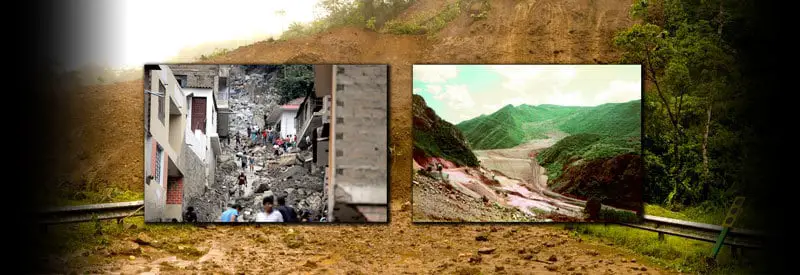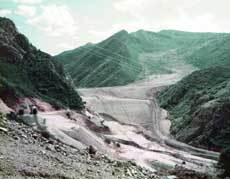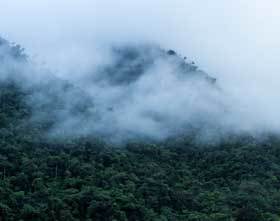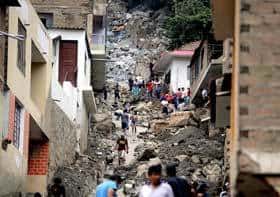Huaycos – What They Are And How They Occur

In the Tropics, an event known as a huayco can cause large-scale destruction and devastation. Although different, its effect is similar to avalanches in snow-covered mountainous areas in arctic regions.
Huayco is the Andean term primarily describing the flash flooding and accompanying mudslides that occur in the Peruvian region of South America due to heavy torrential rains. It originates high in Peru's mountainous regions and is closely related to the weather produced by the El Niño phenomenon.
Regions in and around the Tropics get subjected to large amounts of rainfalls throughout the year. These include areas like the Caribbean, Southeast Asia, Central & South America, as well as the mountainous terrain of Asia. It can have deadly and devastating occurrences.
Due to the heavy torrential rain, flash flooding and mudslides occur quite frequently in these areas, especially in the high mountainous terrain of Peru. These events that are so synonymous with this part of the world are more commonly referred to as a huayco.
This post explores what a huayco is, how it gets formed, and its potentially devastating effect on its surroundings.
What Is A Huayco?
As you might have already concluded, a huayco is a mudslide accompanied by flash flooding, which is the result of heavy rains in the mountains of Peru. It sounds simple enough, but there are, in fact, many more factors at work to create this event.
Before looking at the different mechanisms at work in the formation of this event, though, one first needs a concise formal definition of what precisely a huayco is:
Huayco Definition

Huayco is an Andean term that primarily describes the flash flooding and accompanying mudslides that occur in the Peruvian region of South America due to heavy torrential rains. It originates high in Peru's mountainous regions and is closely related to the weather produced by the El Niño phenomenon.
The weather may be the impetus that sets the process in motion, but it cannot act on its own. The moist, soft soil covering the ground surface, combined with the gravitational force of the steep mountain slopes, largely contributes to the development of a huayco.
In the next section, we will briefly look at the meaning of the term "huayco" and its origins before continuing to explore the formation of this occurrence.
Meaning And Origin Of The Term, Huayco
A huayco is also known as a huaico. When you look at the origin and translation of both these terms, it will become clear how accurately they describe the characteristics of this specific phenomenon.
The word huayco is derived from the Quechuan word wayqu. The Quechuan language is spoken by the Quechua people living in the Andes region of Peru. The term huayco translates to either "valley" or "depth."
The word, huaico, has a Spanish origin (the most widely spoken language in Peru.) It translates to "avalanche," a phenomenon that shares many characteristics with a huaico.
What Causes A Huayco
The Tropics, where Peru is situated, already receives a large amount of rainfall throughout the year. Occasionally, though, a weather phenomenon called El Niño causes the region to receive an abnormally high percentage of precipitation.
In short, an El Niño occurs when the warm waters of the Pacific Ocean that would normally travel west and accumulate at the coast of Southeast Asia are forced to flow in an easterly direction and build up against the northwestern coastline of South America.
(You can learn more about the formation and characteristics of El Niño in this article.)
The moisture-rich water that builds up against the South American coast results in the large-scale formation of rainclouds, which leads to a significant increase in precipitation in regions like Peru.

The increased rainfall causes riverbanks to overflow and runoff areas to exceed their boundaries. This leads to flash flooding over parts of the mountainous terrain in the land.
The dry mountain slopes of the Andes in southern Peru have little or no vegetation cover. Combined with heavy deposits of soil, they are left vulnerable and exposed to extreme weather elements.
During an El Niño event, water from burst river banks and dried-up runoff areas rushes down the mountain slopes while picking up the loose dry soil on the ground. It continues to race down the mountain, gathering even more soil until it starts turning into a dense mudslide.
The sheer momentum and size of the mudslide allow it to pick up objects like rocks and tree trunks, creating a potentially devastating and deadly force capable of wiping out almost anything in its path.
It is this deadly combination of mud, rock, trees (and other objects mixed in) that can completely overwhelm and cover vegetation and small villages at the bottom of the mountain slopes. (More on the impact and effects of a huayco will be discussed in the next section.)
Contributing Factors To Huayco Formation
Although they have already been mentioned in passing, three main contributing factors help to create very favorable conditions for a huayco to occur in the Peruvian region of South America:
- Location of Peru
- Climate of Peru
- Geography of Peru
Although none of these factors cause a huayco by themselves, each one contributes and combined, they create a very favorable environment for the occurrence of this event.
1) Location of Peru
Peru is situated in the Tropics, just south of the Equator. The western part of the country borders the west coast of South America, which makes it highly susceptible to the weather that occurs over the Pacific Ocean (including the El Niño Effect.)
To the east, the Andes Mountains raise the terrain where higher rainfall creates lush vegetation that forms part of the Amazon Rain Forest.
2) Climate of Peru
Since Peru experience a tropical climate, it is subjected to large amounts of rainfall throughout the year, especially in the mountainous region to the east.
However, the influence of the Pacific Ocean to the east creates a drier climate, while the Andes Mountains raise the terrain, creating wet & rainy weather conditions to the east of the country.
It is the contrast between the dry low-lying west and elevated east with its higher rainfall that creates a favorable environment for a huayco to develop.
3) Geography of Peru
Essentially, Peru can be broken up into three geological regions:
- The Amazon Rain Forest
- The Highlands
- The Coast
The Amazon Rain Forest forms the northeastern border of Peru. Although it forms the largest region in Peru (59%), only 12% of the population lives in this region. The relatively flat landscape is covered with dense bush and trees that are so synonymous with the Amazon.
The Highlands mainly consists of the Andes Mountains with its peaks and valleys, reaching a maximum height of 6 768 meters (22 204 feet). It occupies 36% of the land, and 30% of the country's population lives in this area.
The Coast occupies the smallest part of the country (11%), yet the largest part of the population (52%) lives on this relatively small strip of coastal land. The dry yet fertile piece of land extends from the ocean to the foothills of the Andes Mountains.
From the geographical layout of the country, it is clear to see how heavy rainfalls originating in the Andes mountains can trigger a huayco as water rush down the slopes and picks up the dry fertile ground and turn into devastating mudslides.
Effects Of A Huayco
The impact of a huayco can and usually is devastating. The widespread damage and injury (and in most cases, loss of life) of large-scale mudslides have already been well documented and covered in the mainstream media.
To give you an indication of the sheer size and power of a mudslide, the following list of characteristics will provide some perspective:
- Flash flooding can trigger one or multiple mudslides at a time.
- They vary in size, but a typical big mudslide can be 300 meters (984 feet) wide, 50 meters (164 feet) thick, and 1 600 meters (1 000 feet) long.
- Mudslides travel downhill at around 80 km/h (50 mph) but can reach speeds of up to 322 km/h (200 mph) on steep slopes.
- One of the most dangerous aspects of a mudslide is its unpredictability. It can occur suddenly and without warning, leaving little chance to get out of its way.
From these characteristics, it is clear to see just how devastating a mudslide can be. The following is only a summary of the most significant types of impact a huayco can have:
1) Infrastructure Damage And Destruction

The sheer speed and size with which a huayco can strike any area will cause either damage or create complete destruction on a broad scale, depending on the size of the mudslide.
It can bury entire villages under meters of mud and completely destroy roads and bridges. Power lines, railroads, and other forms of information can also get washed away in a matter of minutes.
2) Injuries And Fatalities
Many villages in Peru are situated at the bottom mountain slopes. It makes them especially exposed and vulnerable to a huayco. When a mudslide does occur, it can bury an entire village, as already mentioned.
It usually leads to dozens of fatalities, with hundreds of people left injured and displaced. This is just the scenario for a single small village. When a more extensive region and more communities get affected, this number can easily more than double.
3) Loss Of Crops And Livestock
At the bottom of a slope, a mudslide can quickly spread over large areas. These include large fields of crops that are easily destroyed and can also lead to entire herds of livestock being killed off in minutes.
Since many villages live off the land and rely on their crops and livestock for survival, this can have a severe impact and leave people without food for undetermined periods.
4) Disruption Of Water Supply
Water supply and treatment facilities are also adversely affected by mudslides. Reservoirs can get damaged or destroyed. Even if they do not get demolished, the water of dams and water treatment facilities are polluted with contaminants they carry with them.
Water is the lifeblood of any community, and without it, villages and towns in affected areas will suffer and not be able to endure indefinitely.
5) Economic Cost
It should already be evident from the damage and destruction just described, but the economic impact of strong mudslides on the country is severe. It can quickly run into billions of dollars of damage.
One can easily see how a series of these events in quick succession can put a region and the entire country under extreme financial pressure.
Conclusion
Although mudslides occur all over the world, the conditions that create a huayco in the Peruvian region are quite unique, as was illustrated throughout this post.
This article clearly illustrated what a huayco is and how it develops. It also looked at its defining characteristics and impact on the areas it affects as well as human life.
Never miss out again when another interesting and helpful article is released and stay updated, while also receiving helpful tips & information by simply clicking on this link .
Until next time, keep your eye on the weather!
